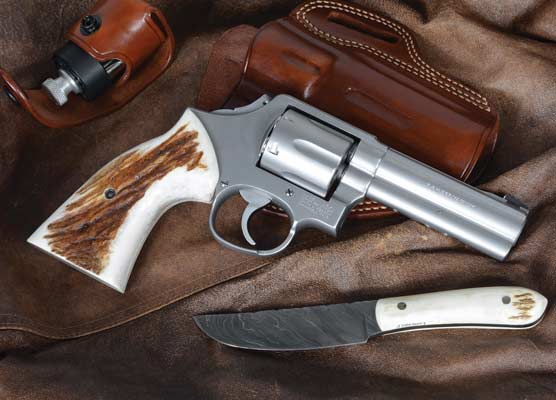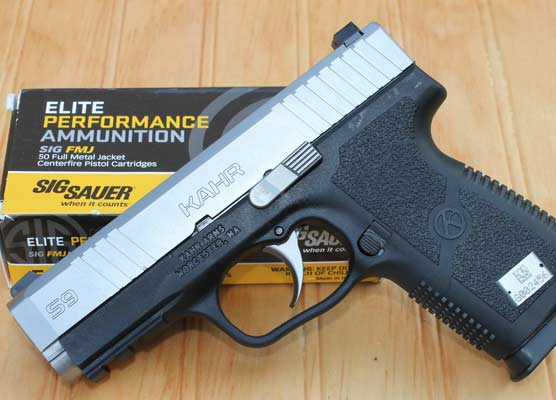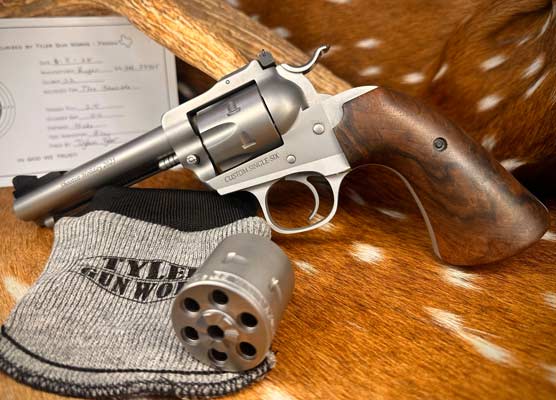Armed Self-Defense in America, the Year American Handgunner Was Born
Situation: A 45th anniversary demands something special.
Lesson: The core dynamics of armed self-defense don’t change much … but the techniques and the hardware — and the laws governing the wherewithal — do.
For 30-some years this section of the magazine has been devoted to studying actual gunfights, with commentary from the participants. For American Handgunner, the special occasion seemed to warrant macrocosm instead of microcosm: an overview of where armed citizens and cops stood in 1976, when the late editor Jerry Rakusan came up with the idea of a magazine devoted to handguns and their legitimate uses. We’ll touch on some high-profile shootings along the way.
Sniper
A decade earlier in Austin, a crazed ex-Marine murdered his wife and mother, then brought a wheelbarrow full of guns and ammunition to the top of the Texas Tower and opened fire. Eighteen people died and 31 were wounded. Police buckshot and .38 Special proved impotent against him from the ground below, but rifle fire from armed citizens forced the gunman to keep his head down. This ended the slaughter until private citizen Allen Crum led police to the top of the tower from the inside. Crum fired the first shot of the rooftop encounter in which APD officers Houston McCoy and Ray Martinez finally shot the mad sniper to death with a Winchester 12-gauge pump and a department issue S&W .38/44 Heavy Duty.
In 1976 history repeated itself when another whack job did something similar, pouring rifle fire into the streets below from a high balcony of a 26-story Holiday Inn in Wichita, Kansas. Swiftly employing the strategy that had stopped the slaughter in Austin, police raced up the inside of the structure to engage the suspect. Wichita hero cop Mike Hill charged the sniper’s balcony perch, pumping buckshot into the sniper through a glass door, neutralizing him before his death toll could approach that of the Texas Tower incident.
Deadly when unopposed, the cowardly murderer had no stomach for fighting armed men. He dropped his weapon and squealed he wanted to give up. Quick police response had limited the butcher’s bill to three dead and six wounded. The killing spree had lasted only 11 minutes. Hill would say later, “We didn’t have SWAT. The responding people took care of it.” Hill and his brother officers had learned, benevolently, from recent history.
Serial Killer
The “Son of Sam” killing spree began in mid-1976 and ended 12 months later. The sick stalker left a trail of dead and crippled victims, usually couples he had ambushed as they sat in automobiles. The crime lab determined the bullets had come from a Charter Arms Bulldog .44 Special revolver, and the media at first dubbed him “the .44 Caliber Killer.” If you had registered a Charter Bulldog .44 in the NYC area, you could expect a visit from the police, and anti-gunners of the period danced in the blood because they hadn’t yet discovered “assault rifles” and were then focused on banning the concealable handguns they called “Saturday Night Specials.” When the killer at last faced cops with guns pointed at him, he surrendered meekly. Those of us who lived in right-to-carry jurisdictions wondered how much sooner the horror might have ended if any of his victims had been armed and able to shoot back.
Private Citizen Carry In 1976
The majority of states that did have concealed carry were “may issue,” that is, it was left to the discretion of the issuing authority whether to grant the permit. In many jurisdictions “may issue” became a code term for “We’ll give you the permit if you’re white, male, rich and politically connected.” Relatively few states were “shall issue,” meaning authorities were required by law to issue to any requesting adult with clean criminal record or show good cause why not.
One such shall issue environment was New Hampshire, whose state motto was and is “Live Free or Die.” In 2021, may issue is the exception rather than the rule, with 39 states having written shall issue into their laws.
In 1976 there was but one state, Vermont, allowing concealed carry of a loaded handgun by a law-abiding citizen without a permit. Perhaps not coincidentally, Vermont has always had one of the lowest violent crime states per capita. Today, there are a dozen states following the Vermont Model of so-called Constitutional Carry for all law-abiding citizens, including visitors, and three more that allow permitless carry by their own state’s residents.
In 1976 there were seven states where there was no provision for an ordinary law-abiding citizen to carry a loaded, concealed handgun in public: Texas, Louisiana, Ohio, Kansas, Wisconsin, Oklahoma and Illinois. Today, every state has some provision for a carry permit in their statutes. Those seven came on line one by one, all in shall issue mode, in 1995, 1996, 2004, 2007, 2011, 2012 and 2013 respectively.
In 1976, only two states, Indiana and Michigan, recognized carry permits issued in other states. Today, some states have “limited reciprocity” meaning they recognize only permits from states that recognize theirs, and many others have “total reciprocity” recognizing permits from all other states. Indeed, only a few states still recognize no other permits and don’t issue non-resident permits: New York, New Jersey, Washington state and Maryland.
Of course, there were outspoken and well-funded forces opposing armed self-defense and even ownership of handguns in 1976. Handgun Control, Inc. had been founded two years prior, and would eventually morph into the Brady Organization of today. Opposing them were the NRA, the Second Amendment Foundation founded two years before by Alan Gottlieb, and SAF’s sister group, the Citizens Committee for the Right to Keep and Bear Arms, founded in 1971.
1976 was the year in which the gun owners’ civil rights groups joined hands to successfully defeat a referendum that would have banned civilian possession of handguns in the state of Massachusetts.
Armed Citizen Training
In 1976, Col. Jeff Cooper and his wonderful wife Janelle opened Gunsite in Paulden, Ariz. Shortly thereafter his contemporary, world combat pistol champion Ray Chapman, opened the Chapman Academy of Practical Shooting in Columbia, Mo. It was a watershed for armed American citizens.
Prior to that time, the only formalized pistol training available to private citizens was from the NRA, and that was primarily safety and marksmanship. Its zenith was the pistol school offered once a year at the NRA-sponsored National Pistol Championships at Camp Perry, Ohio, which limited its curriculum to bullseye match shooting.
Cooper opened the door to true defensive deadly weapons training for private citizens that had not existed since the sailles des armes, the dueling schools for rich young gentlemen in the Deep South in the antebellum years. In ’76, the FBI was still teaching hip-shooting at seven yards. Cooper’s breakthrough would quickly advance police training nationwide.
Cooper and his associates had a banner year in ’76. It was also the year he and Chapman hosted the Columbia Conference at Chapman Academy in Columbia, Mo., where IPSC was formed. The International Practical Shooting Confederation spread the sport of simulated defensive shooting worldwide and sparked numerous practical shooting sports, including IDPA (“the concealed carry sport”), Steel Challenge and Three-Gun competition. The governing body of IPSC in this country is USPSA, the United States Practical Shooting Association. All contributed to better skills and shooting techniques for The Good Guys and Gals.
The ‘Good Guys’ Armory
A gun dealer in 1976 would tell you for the most part, armed citizens who carried concealed pretty much followed the plainclothes police model of the time. The “snub-nose .38 Special” was the most commonly carried gun when out and about. There are few official resources, but those that exist support the point.
It was about then New Hampshire gun owners rose up against a couple of newspapers in their state, furious those papers were getting lists of concealed carry permits from the chiefs of police who issued them and publishing them with names and addresses. One city asked for a particular gun to be listed by serial number on the permit, though the carrier was not limited to that one firearm. The gun owners prevailed, and a law was passed to make the information “need to know only,” but the artifacts of the articles exist. The paper in question listed most often the S&W .38, and second most often the Colt .38. In New York City, which did limit the concealed carrier to one gun by serial number (two, if they were lucky), the snub .38 was again the most common choice.
Those who wanted a small auto tended toward the Walther .380. The 1968 Gun Control Act had limited imports, and (anti-gun politicians having different standards back then) you could import a higher capacity gun easier than a lower capacity one, so the German Walther PPK/s (with the short PPK barrel/slide but the larger PP grip frame and magazine) was destined to become a “best-seller” in its class. Yes, the James Bond movies did have something to do with that.
On the other side of the power scale, Jeff Cooper did much to popularize the 1911 .45 auto among serious concealed carriers. In 1976, if you were serious about a .45 auto, you wanted the Colt. It was not the company’s finest hour for quality control: many of American Handgunner’s readers considered a new Colt .45 auto in 1976 to be raw material for custom gunsmiths, and one of my colleagues described them as “an assortment of 1911 parts, thoughtfully assembled before you bought them.” Today’s Colt 1911s are much, much better.
In home defense handguns, the revolver was still the most popular. The most common were the 4″ barrel service six-guns in .38 Special and .357 Magnum. One of the most popular gunwriters of the time, Jack O’Connor, was a rifleman first, a shotgunner second, and a handgunner a distant third. In one of his gun books of the period, he actually subcontracted the handgun section to Jeff Cooper. O’Connor wrote the handgun he personally kept for home defense was a 6″ barrel S&W K-38 target revolver. His bête noir in gunwriting, Elmer Keith, preferred a 4″ barrel S&W .44 Magnum, just as he preferred large-bore rifles over O’Connor’s signature .270 Winchester. More of the general public went O’Connor’s way than Keith’s, and a lot of military vets went with the gun Uncle Sam had trained them on, what was then known generically as the “.45 automatic.”
The Police Side
In 1976, 207 American police officers died in the line of duty. Eight of those were stabbed to death, something to remember the next time we hear the phrase, “he only had a knife.” More than that were killed by intentional vehicular assault, something to keep in mind the next time we see a headline that says, “Unarmed motorist shot by police.”
New York City recorded 1,622 murders in 1976, down by 23 from the 1975 tally. Almost half of the victims had criminal records. Layoffs and attrition had brought police manpower down from 27,262 in 1974 to 22,304 in 1976, serving a population of approximately 8 million people.
The NYPD instituted SOP 9 in 1970 when the legendary Lt. Frank McGee took over the department’s Firearms Training Unit and turned it into the Firearms and Tactics Unit. Standard Operating Procedure number 9 encompassed the intensive debriefing of every member of the service who fired a shot anywhere but on the range and included round count, distance, shooting stance and whether the officer took cover or used his sights.
The SOP 9 stats for 1976 showed 11 officers shot and wounded and one officer killed. That was down from a peak of 50 cops wounded and seven officers slain in 1973. Forty-seven NYPD officers were wounded and a dozen killed in 1971.
On the other side of the ledger, cops shot and wounded 79 criminal suspects, and killed another 25 in 1976. This was also down from a prior high year, 1971, in which NYPD officers had shot and wounded 221 perpetrators and killed another 93. 1976 showed 379 officer-involved shooting incidents, compared to 810 in 1971 and 994 in 1972. In the field in 1976 the officers had fired 994 shots, less than half of the 2,113 discharged in 1971 and 2,510 in 1972. The year 2021, thankfully, finds all these numbers much lower.
The SOP 9 stats were (and still are) extremely valuable, because it is rare to find any other law enforcement agency tracking those numbers so meticulously. The UCR, Uniform Crime Reports, have not been turned in by every single law enforcement entity.
The following is from Death on Patrol: Felonious Homicides of American Police Officers, A Report to the National Institute of Justice from the Police Foundation written by Lorie Fridell of FSU and Antony Pate of Police Foundation, March 1995: “The FBI first began collecting data on felonious killings of police officers in 1945. The information was first reported, starting in 1961, in the annual UCR publication Crime in the United States. In 1972 the UCR developed a separate publication, Law Enforcement Officers Killed, which focused on officers killed in the line of duty. Indeed, it was in the early 1970s that general compliance by law enforcement agencies with the voluntary reporting system was achieved. The amount of and quality of data regarding these incidents have improved progressively since that time and are considered the most reliable of all data collected in the UCR.”
Unfortunately, then — and to this day — there is no complete national database of all police gunfights, nor, for that matter, all self-defense shootings involving armed citizens.
Disarms And Retention
Jodi M. Brown and Patrick A. Langan, Ph.D. later wrote in Policing and Homicide, 1976-98: Justifiable Homicide by Police, Police Officers Murdered by Felons that in 1976 14% of slain officers were killed with their own weapons, a trend that peaked in 1986 at 23%.
The year 1976 was the dawn of a police training movement which would go far toward changing that. It was during that year when true “handgun retention” training was crystallized. The Kansas City, Mo. area experienced a spate of disarming of police with tragic results and Jim Lindell, lead defensive tactics instructor for the KC Regional Police Academy, was tasked with developing a program that would defeat disarming attempts whether from hand or holster. The Lindell Method, also known as the Kansas City system, taught cops techniques based primarily on leverage to defeat grabs to the drawn or holstered gun.
Today, 45 years later, it has been estimated Lindell’s pioneering training has likely saved as many cops from death as the soft body armor created by armed citizen and Second Amendment advocate Richard Davis in 1972. For perspective, the Kevlar Survivor’s Club at this writing now lists over 3,100 “saves” thanks to Davis’ invention. Many of those vests stopped bullets from snatched police weapons.
Today, a much smaller percentage of slain officers die in front of their own guns. Another reason for this is the virtually universal adoption of uniform security holsters. John Bianchi and his lead designer Richard Nichols pioneered that in 1976, and waiting in the wings was Bill Rogers, whose snatch-resistant designs produced by Safariland are now virtually standard in American law enforcement. Over the years, American Handgunner has paid homage to all of these life savers.
Looking Back
In the almost half-century since American Handgunner was founded, we’ve seen a lot of changes. The confluence of disasters in 2020 saw a huge influx of newly armed American citizens. Far more people are able to protect themselves and their families than in 1976. Our guns, holsters, ammunition and available training in shooting and tactics have advanced exponentially.
I’m grateful to have been a part of American Handgunner since its first issue, and proud of the influence the magazine has had. Next issue, this corner of the magazine will return to its original format of gunfight (and aftermath) analysis. This time around, thank you, our readers, for being instrumental in American Handgunner’s success in the fight to protect gun owners’ civil rights, including the right to protect oneself and the other innocent people we are responsible for, from criminal, homicidal evil.




